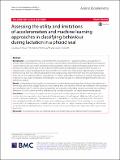Files in this item
Assessing the utility and limitations of accelerometers and machine learning approaches in classifying behaviour during lactation in a phocid seal
Item metadata
| dc.contributor.author | Schuert, Courtney | |
| dc.contributor.author | Pomeroy, Patrick | |
| dc.contributor.author | Twiss, Sean | |
| dc.date.accessioned | 2018-10-17T10:30:11Z | |
| dc.date.available | 2018-10-17T10:30:11Z | |
| dc.date.issued | 2018-10-16 | |
| dc.identifier | 255932668 | |
| dc.identifier | 0f248f59-9a4c-4bc1-8658-1e384fc9de41 | |
| dc.identifier | 85054869267 | |
| dc.identifier.citation | Schuert , C , Pomeroy , P & Twiss , S 2018 , ' Assessing the utility and limitations of accelerometers and machine learning approaches in classifying behaviour during lactation in a phocid seal ' , Animal Biotelemetry , vol. 6 , 14 . https://doi.org/10.1186/s40317-018-0158-y | en |
| dc.identifier.issn | 2050-3385 | |
| dc.identifier.other | ORCID: /0000-0003-1603-5630/work/49580160 | |
| dc.identifier.uri | https://hdl.handle.net/10023/16253 | |
| dc.description | Funding for this work was provided by the Durham Doctoral Studentship scheme at Durham University and supported by Natural Environment Research Council’s core funding to the Sea Mammal Research Unit at the University of St. Andrews. | en |
| dc.description.abstract | Background: Classifying behaviour with animal-borne accelerometers is quickly becoming a popular tool for remotely observing behavioural states in a variety of species. Most accelerometry work in pinnipeds has focused on classifying behaviour at sea often quantifying behavioural trade-offs associated with foraging and diving in income breeders. Very little work to date has been done to resolve behaviour during the critical period of lactation in a capital breeder. Capital breeding phocids possess finite reserves that they must allocate appropriately to maintain themselves and their new offspring during their brief nursing period. Within this short time, fine-scale behavioural trade-offs can have significant fitness consequences for mother and offspring and must be carefully managed. Here, we present a case study in extracting and classifying lactation behaviours in a wild, breeding pinniped, the grey seal (Halichoerus grypus). Results: Using random forest models, we were able to resolve 4 behavioural states that constitute the majority of a female grey seals’ activity budget during lactation. Resting, alert, nursing, and a form of pup interaction were extracted and classified reliably. For the first time, we quantified the potential confounding variance associated with individual differences in a wild context as well as differences due to sampling location in a largely inactive model species. Conclusions: At this stage, the majority of a female grey seal’s activity budget was classified well using accelerometers, but some rare and context-dependent behaviours were not well captured. While we did find significant variation between individuals in behavioural mechanics, individuals did not differ significantly within themselves; inter-individual variability should be an important consideration in future efforts. These methods can be extended to other efforts to study grey seals and other pinnipeds who exhibit a capital breeding system. Using accelerometers to classify behaviour during lactation allows for fine-scale assessments of time and energy trade-offs for species with fixed stores. | |
| dc.format.extent | 17 | |
| dc.format.extent | 1340526 | |
| dc.language.iso | eng | |
| dc.relation.ispartof | Animal Biotelemetry | en |
| dc.rights | © The Author(s) 2018. This article is distributed under the terms of the Creative Commons Attribution 4.0 International License (http://creativecommons.org/licenses/by/4.0/), which permits unrestricted use, distribution, and reproduction in any medium, provided you give appropriate credit to the original author(s) and the source, provide a link to the Creative Commons license, and indicate if changes were made. The Creative Commons Public Domain Dedication waiver (http://creativecommons.org/publicdomain/zero/1.0/) applies to the data made available in this article, unless otherwise stated. | en |
| dc.subject | Accelerometer | en |
| dc.subject | Grey seal | en |
| dc.subject | Maternal behaviour | en |
| dc.subject | Breeding behaviour | en |
| dc.subject | Machine learning | en |
| dc.subject | Classification | en |
| dc.subject | QH301 Biology | en |
| dc.subject | NDAS | en |
| dc.subject | NERC | en |
| dc.subject.lcc | QH301 | en |
| dc.title | Assessing the utility and limitations of accelerometers and machine learning approaches in classifying behaviour during lactation in a phocid seal | en |
| dc.type | Journal article | en |
| dc.contributor.institution | University of St Andrews.School of Biology | en |
| dc.contributor.institution | University of St Andrews.Sea Mammal Research Unit | en |
| dc.contributor.institution | University of St Andrews.Marine Alliance for Science & Technology Scotland | en |
| dc.contributor.institution | University of St Andrews.Scottish Oceans Institute | en |
| dc.contributor.institution | University of St Andrews.Centre for Research into Ecological & Environmental Modelling | en |
| dc.identifier.doi | 10.1186/s40317-018-0158-y | |
| dc.description.status | Peer reviewed | en |
This item appears in the following Collection(s)
Items in the St Andrews Research Repository are protected by copyright, with all rights reserved, unless otherwise indicated.

